Analysis of an Evaporative Cooling Pad Connected to an Air Distribution System of Perforated Polyethylene Tubes in a Greenhouse
Abstract
:1. Introduction
2. Materials and Methods
2.1. Sizing of the System
- The pad material is uniformly and completely wetted;
- The transfer coefficients of mass and energy by convection of humid air on the surface of liquid water are constant;
- The thermal properties of air and water are constant;
- The temperature at the water–air interface is constant and uniform;
- Le = 1;
- The air close to the water–air interface is saturated at the water temperature;
- The air temperature only changes in the x-direction;
- The air is considered incompressible.
2.1.1. Optimal Point of Operation of the Installation
2.1.2. Climate Inside the Greenhouse
2.2. Technical Viability of the System
3. Results and Discussion
3.1. Cooling System and Air Distribution
3.2. Evaporative Cooling
3.3. Temperature of the Air as It Exits the Pad
3.4. Evaporative Cooling and Performance
3.5. Temperature inside the Greenhouse
3.6. Variation in the Frequency of the Extractor Driver
4. Conclusions
Author Contributions
Funding
Data Availability Statement
Conflicts of Interest
Abbreviations
| P | Perturbance variable |
| X | Unknown variable |
| V | Known value variable |
| C | Constant value variable |
| Variables | |
| T | temperature (K, °C) |
| RH | Relative humidity (%) |
| p | Pressure (Pa) |
| vv | Wind speed outside (m s−1) |
| Dv | Wind direction outside (°) |
| SR | Solar radiation outside (W m−2) |
| PAR | Photosynthetically active radiation (µmol m−2 s−1) |
| η | Evaporative efficiency of the fan pad system (%) |
| ω | Relative humidity of the air (kgv kga−1) |
| ve | Wind speed as it passes through the pad (m s−1) |
| v | Wind speed (m s−1) |
| Q | Energy exchanged as heat (J) |
| W | Mechanical power transferred by the fan (W) |
| μ | Fan performance (%) |
| t | Time (s) |
| m | Mass (kg) |
| V | Volume (m3) |
| cp | Specific heat (J kg−1 K−1) |
| λ | Latent heat (J kg−1) |
| hc | Coefficient of energy transfer as heat due to convection (W m−2 K−1) |
| hm | Coefficient of mass transfer (kg m−2 s−1) |
| Le | Lewis number (-) |
| ξ | Porous surface per unit of volume of the panel (m2 m−3) |
| B | Base or thickness of the panel (m) |
| H | Panel height (m) |
| δ | Thickness of the panel (m) |
| x | Direction perpendicular to the main area of the panel (m) |
| ρ | Density (kg m−3) |
| P | Proportionality coefficient characteristic of the panel (kg sn−3 m−n K−1) |
| β | Factor of integration (sn−1 m−n) |
| n | Coefficient characteristic of the panel (-) |
| i | number of perforations in a line of perforations (-). |
| N | Number of perforation lines along the inflatable distribution line (-). |
| L | Space between contiguous perforation lines along the inflatable duct (m) |
| M | Total length of the inflatable duct (m) |
| f | Darcy friction factor (-) |
| Re | Reynolds number (-) |
| D | Diameter of the inflatable duct (m) |
| C | Coefficient of localized pressure losses in a duct (-) |
| pe | Static pressure in the interior of the hose (Pa) |
| pd | Dynamic pressure in the interior of the hose (Pa) |
| E | Extinction coefficient of solar radiation (-) |
| A | First coefficient of crop evapotranspiration (s2 m−2) |
| B | First coefficient of crop evapotranspiration (s m−1) |
| LAI | Leaf area index (m2 m−2) |
| VPD | Vapor pressure deficit (Pa) |
| ET | Evapotranspiration (kg m−2 s) |
| d | Depth (m) |
| k | Coefficient of thermal conductivity (W m−1 s−1) |
| hcc | Global coefficient of energy transfer by convection–conduction between the duct and the air in the greenhouse (W m−2 °C−1) |
| S | Surface (m2) |
| α | Radiation absorption coefficient (-) |
| τ | Radiation transmission coefficient (-) |
| σ | Stefan-Boltzmann constant (5.67·10−8 W m−2·K−4) |
| K | Global heat transfer coefficient (W m−2 K−1) |
| F | Flow rate (m3 s−1) |
| h | Specific enthalpy (J kg−1) |
| n | Angular frequency (Hz, rpm) |
| Other sub-indices | |
| v | Vapor |
| a | Air |
| w | State of adiabatic saturation |
| w | Humid, referring to temperature |
| p | Pad |
| c | Evaporative pre-chamber |
| o | Exterior |
| o | With evapotranspiration, reference |
| g | Greenhouse |
| pid | perforated inflatable duct |
| e | Exit |
| s | Saturated |
| se | Sensible |
| la | Latent |
| cr | Crop |
| so | Soil |
| rad | Radiation |
| cov | Roof |
| enc | Enclosure |
| fl | Floor |
| atm | Atmospheric |
| ter | Thermal |
| cd | Conduction |
| cv | Convection |
| cc | Conduction-convection |
| des | Design |
Appendix A
Appendix B
Appendix C
Appendix D
Appendix E
Appendix F
References
- Tawalbeh, M.; Aljaghoub, H.; Alami, A.H.; Olabi, A.G. Selection criteria of cooling technologies for sustainable greenhouses: A comprehensive review. Therm. Sci. Eng. Prog. 2023, 38, 101666. [Google Scholar] [CrossRef]
- Dehbi, A.; Youssef, B.; Chappey, C.; Mourad, A.-H.; Picuno, P.; Statuto, D. Multilayers Polyethylene Film for Crop Protection in Harsh Climatic Conditions. Adv. Mater. Sci. Eng. 2017, 2017, 4205862. [Google Scholar] [CrossRef]
- Moreno-Teruel, M.Á.; Molina-Aiz, F.D.; López-Martínez, A.; Marín-Membrive, P.; Peña-Fernández, A.; Valera-Martínez, D.L. The Influence of Different Cooling Systems on the Microclimate, Photosynthetic Activity and Yield of a Tomato Crops (Lycopersicum esculentum Mill.) in Mediterranean Greenhouses. Agronomy 2022, 12, 524. [Google Scholar] [CrossRef]
- Sahdev, R.K.; Dhingra, A.K.; Kumar, M. A comprehensive review of greenhouse shapes and its applications. Front. Energy 2019, 13, 427–438. [Google Scholar]
- Ghani, S.; Bakochristou, F.; ElBialy, E.M.A.A.; Gamaledin, S.M.A.; Rashwan, M.M.; Abdelhalim, A.M.; Ismail, S.M. Design challenges of agricultural greenhouses in hot and arid environments—A review. Eng. Agric. Environ. Food 2019, 12, 48–70. [Google Scholar] [CrossRef]
- Katsoulas, N.; Sapounas, A.; De Zwart, F.; Dieleman, J.A.; Stanghellini, C. Reducing ventilation requirements in semi-closed greenhouses increases water use efficiency. Agric. Water Manag. 2015, 156, 90–99. [Google Scholar] [CrossRef]
- Hegazy, A.; Farid, M.; Subiantoro, A.; Norris, S. Sustainable cooling strategies to minimize water consumption in a greenhouse in a hot arid region. Agric. Water Manag. 2022, 274, 107960. [Google Scholar] [CrossRef]
- Quillec, S.L.; Albert, B.; Lesourd, D.; Loda, D.; Barette, R.; Brajeul, E. Benefits of a semi-closed greenhouse for tomato production in the West of France. Acta Hortic. 2017, 1170, 883–888. [Google Scholar] [CrossRef]
- Coomans, M.; Allaerts, K.; Wittemans, L.; Pinxteren, D. Monitoring and energetic performance of two similar semi-closed greenhouse ventilation systems. Energy Convers. Manag. 2013, 76, 128–136. [Google Scholar] [CrossRef]
- Dannehl, D.; Josuttis, M.; Ulrichs, C.; Schmidt, U. The potential of a confined closed greenhouse in terms of sustainable production, crop growth, yield and valuable plant compounds of tomatoes. J. Appl. Bot. Food Qual. 2014, 87, 210–219. [Google Scholar]
- Van’t Ooster, A.; Van Ieperen, W.; Kalaitzoglou, P. Model study on applicability of a semi closed greenhouse concept in Almeria: Effects on greenhouse climate, crop yield and resource use efficiency. Acta Hortic. 2012, 927, 51–58. [Google Scholar] [CrossRef]
- Gieling, T.H.; Dieleman, J.A.; Janssen, H.J.J.; Campen, J.B.; Raaphorst, M.G.M.; Kromwijka, J.A.M.; Kempkes, F.L.K.; Garcia, N. Monitoring of climate variables in semi-closed greenhouses. Acta Hortic. 2015, 893, 1073–1080. [Google Scholar] [CrossRef]
- Heuvelink, E.; Bakker, M.; Marcelis, L.F.M.; Raaphorst, M. Climate and Yield in a Closed Greenhouse. Acta Hortic. 2008, 801, 1083–1092. [Google Scholar] [CrossRef]
- Qian, T.; Dieleman, J.A.; Elings, A.; De Gelder, A.; Marcelis, L.F.M.; Van Kooten, A.O. Comparison of climate and production in closed, semi-closed and open greenhouses. Acta Hortic. 2011, 893, 807–814. [Google Scholar] [CrossRef]
- de Zwart, H.F. Overall energy analysis of (semi) closed greenhouses. Acta Hortic. 2008, 801, 811–818. [Google Scholar] [CrossRef]
- ATECYR. Selección de Equipos de Transporte de Fluidos. Guía Técnica; IDEA: Madrid, Spain, 2012; 102p. [Google Scholar]
- Sapounas, A.; Katsoulas, N.; Slager, B.; Bezemer, R.; Lelieveld, C. Design, Control, and Performance Aspects of Semi-Closed Greenhouses. Agronomy 2020, 10, 1739. [Google Scholar] [CrossRef]
- Kumar, K.S.; Tiwari, K.N.; Jha, M.K. Design and technology for greenhouse cooling in tropical and subtropical regions: A review. Energy Build. 2009, 41, 1269–1275. [Google Scholar] [CrossRef]
- Sethi, V.; Sharma, S. Survey of cooling technologies for worldwide agricultural greenhouse applications. Sol. Energy 2007, 81, 1447–1459. [Google Scholar] [CrossRef]
- López, A.; Valera, D.L.; Molina-Aiz, F.D.; Peña, A. Sonic anemometry to evaluate airflow characteristics and temperature distribution in empty Mediterranean greenhouses equipped with pad-fan and fog systems. Biosyst. Eng. 2012, 113, 334–350. [Google Scholar] [CrossRef]
- Misra, D.; Ghosh, S. Evaporative cooling technologies for greenhouses: A comprehensive review. Agric. Eng. Int. CIGR J. 2018, 20, 1–15. [Google Scholar]
- Cámara-Zapata, J.M.; Sánchez-Molina, J.A.; Wang, H.; Carreño-Ortega, A.; Rodríguez, F. Evaluation of an Adapted Greenhouse Cooling System with Pre-Chamber and Inflatable Air Ducts for Semi-Arid Regions in Warm Conditions. Agronomy 2020, 10, 752. [Google Scholar] [CrossRef]
- Gupta, S.K.; Arora, B.B.; Arora, A. Effect of varying ambient conditions on the performance of air conditioner using evaporative cooler. J. Braz. Soc. Mech. Sci. 2023, 45, 625. [Google Scholar] [CrossRef]
- von Zabeltitz, C. Integrated Greenhouse Systems for Mild Climates; Springer: Berlin, Germany, 2011; 363p. [Google Scholar]
- Sabeh, N.C.; Giacomelli, G.A.; Kubota, C. Water use for pad and fan cooling of a greenhouse in a semi-arid climate. Acta Hortic. 2006, 719, 409–416. [Google Scholar] [CrossRef]
- Sabeh, N.C. Evaluation and Minimizing of Water Use by Greenhouse Evaporative Cooling Systems in a Semi-Arid Climate. Ph.D. Thesis, Department of Agricultural and Biosystems Engineering, University of Arizona, Tucson, AZ, USA, 2007; 216p. [Google Scholar]
- Ghoulem, M.; El Moueddeb, K.; Nehdi, E.; Boukhanouf, R.; Calautit, J.K. Greenhouse design and cooling technologies for sustainable food cultivation in hot climates: Review of current practice and future status. Biosyst. Eng. 2019, 183, 121–150. [Google Scholar] [CrossRef]
- Wu, J.M.; Huang, X.; Zhang, H. Theoretical analysis on heat and mass transfer in a direct evaporative cooler. Appl. Therm. Eng. 2009, 29, 980–984. [Google Scholar] [CrossRef]
- Suoying, H.; Gurgenci, H.; Guan, Z.; Alkhedhair, A.M. Pre-cooling with Munters media to improve the performance of Natural Draft Dry Cooling Towers. Appl. Therm. Eng. 2013, 53, 67–77. [Google Scholar]
- Rabbi, B.; Chen, Z.-H.; Sethuvenkatraman, S. Protected cropping in warm climates: A review of humidity control and cooling methods. Energies 2019, 12, 2737. [Google Scholar] [CrossRef]
- Fuchs, M.; Dayan, E.; Presnov, E. Evaporative cooling of a ventilated greenhouse rose crop. Agric. For. Meteorol. 2006, 138, 203–215. [Google Scholar] [CrossRef]
- Jamaludin, D.; Ahmad, D.; Kamaruddin, R.; Jaafar, H.Z.E. Microclimate inside a tropical greenhouse equipped with evaporative cooling pads. J. Sci. Technol. 2014, 22, 255–272. [Google Scholar]
- Ganguly, A.; Ghosh, S. Modeling and analysis of a fan–pad ventilated floricultural greenhouse. Energy Build. 2007, 39, 1092–1097. [Google Scholar] [CrossRef]
- Al-Jamal, K. Greenhouse cooling in hot countries. Energy 1994, 19, 1187–1192. [Google Scholar] [CrossRef]
- Sarntichartsak, P.; Thepa, S. Modeling and experimental study on the performance of an inverter air conditioner using R-410A with evaporatively cooled condenser. ATE 2013, 51, 597–610. [Google Scholar] [CrossRef]
- Kays, W.M.; London, A.L. Compact Heat Exchangers, 3rd ed.; McGraw-Hill: New York, NY, USA, 1984; 156p. [Google Scholar]
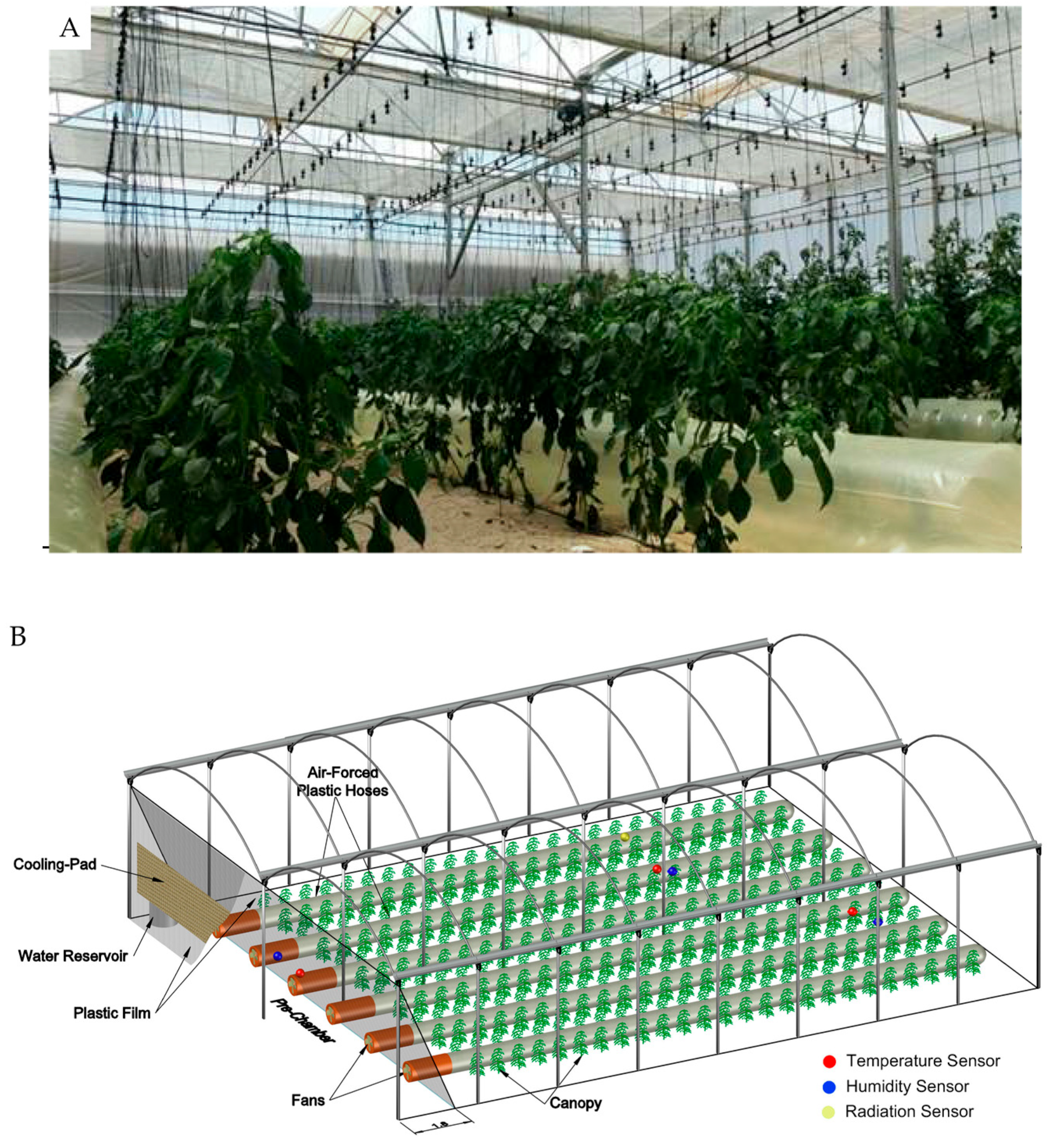
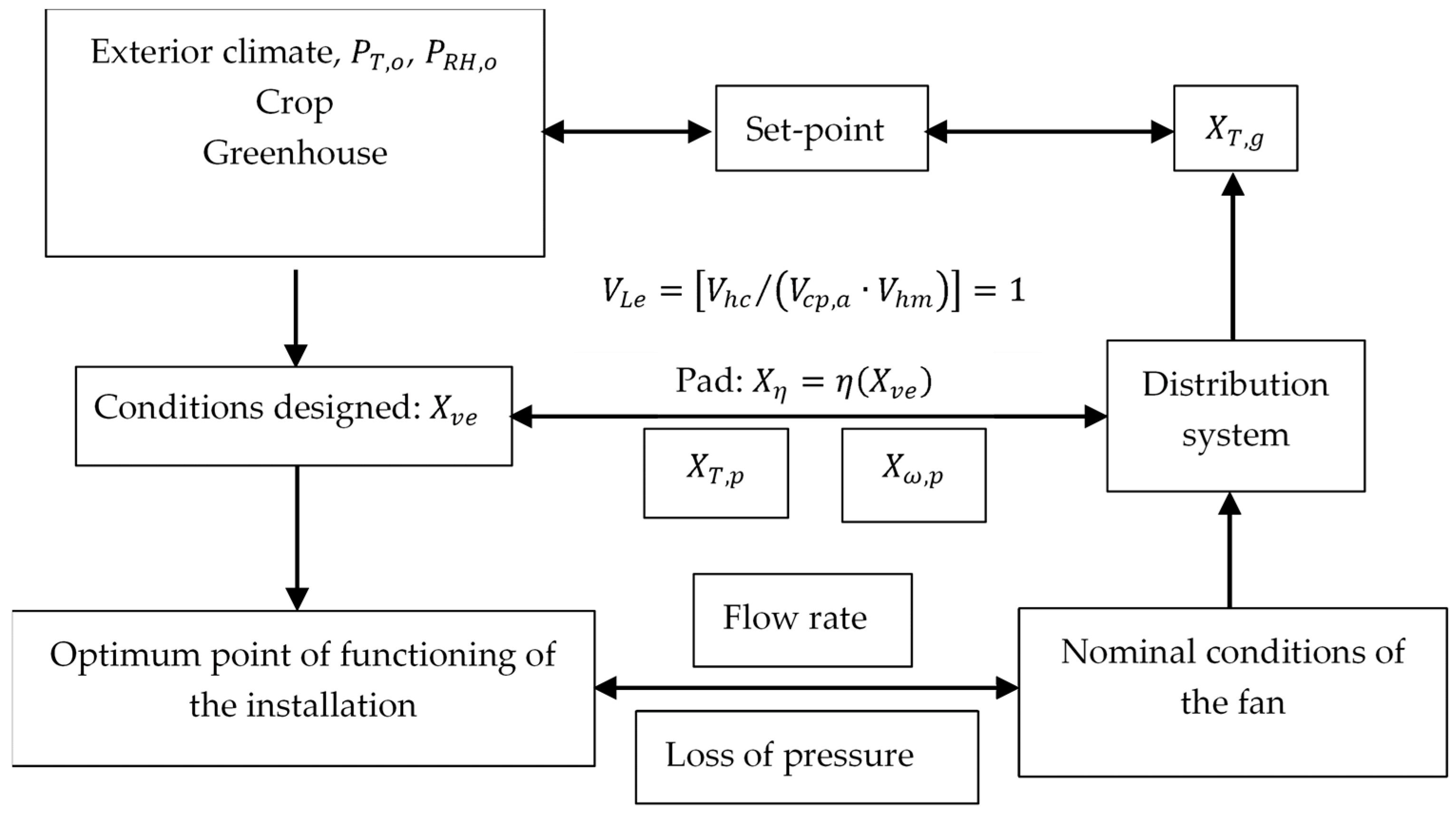
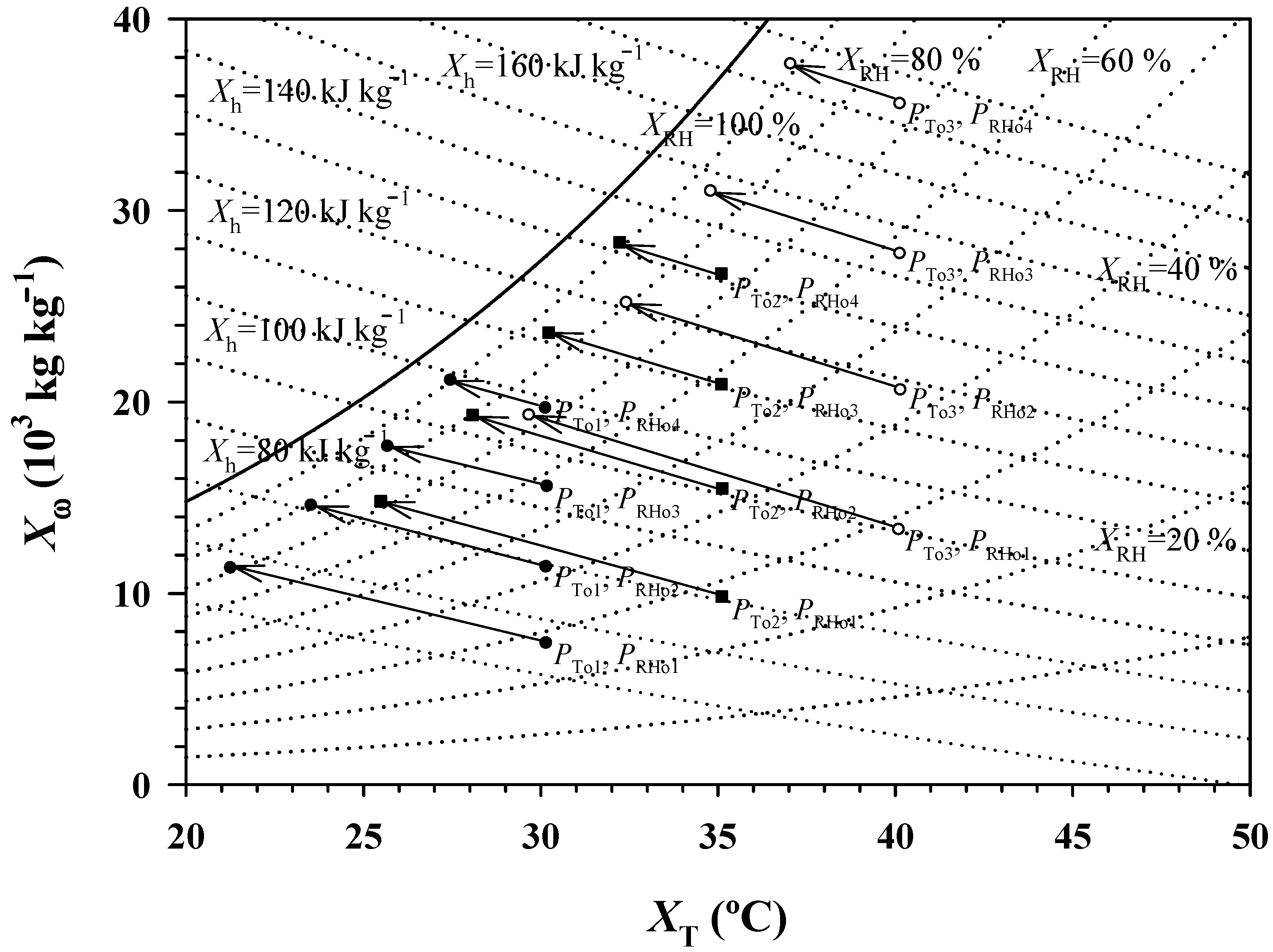



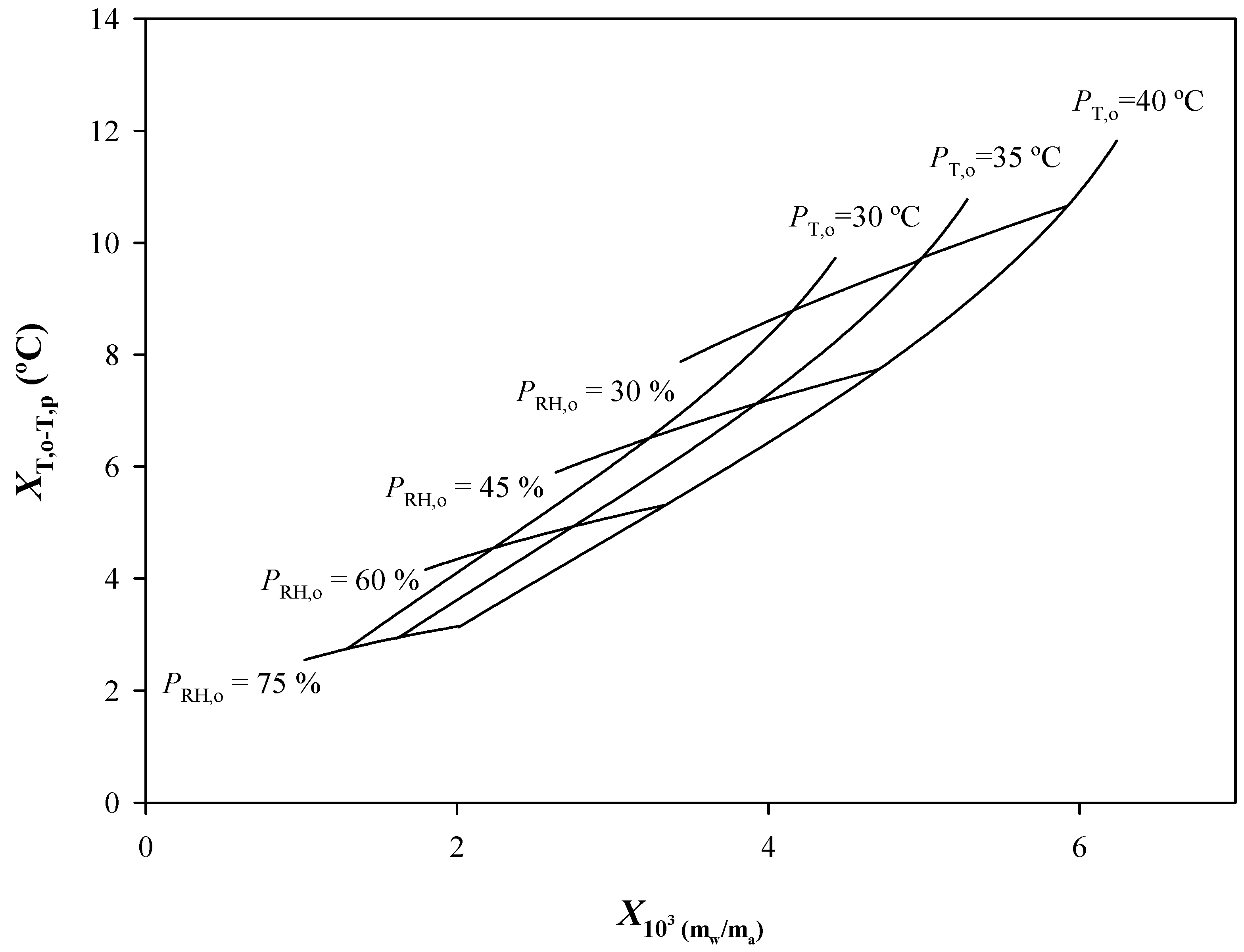

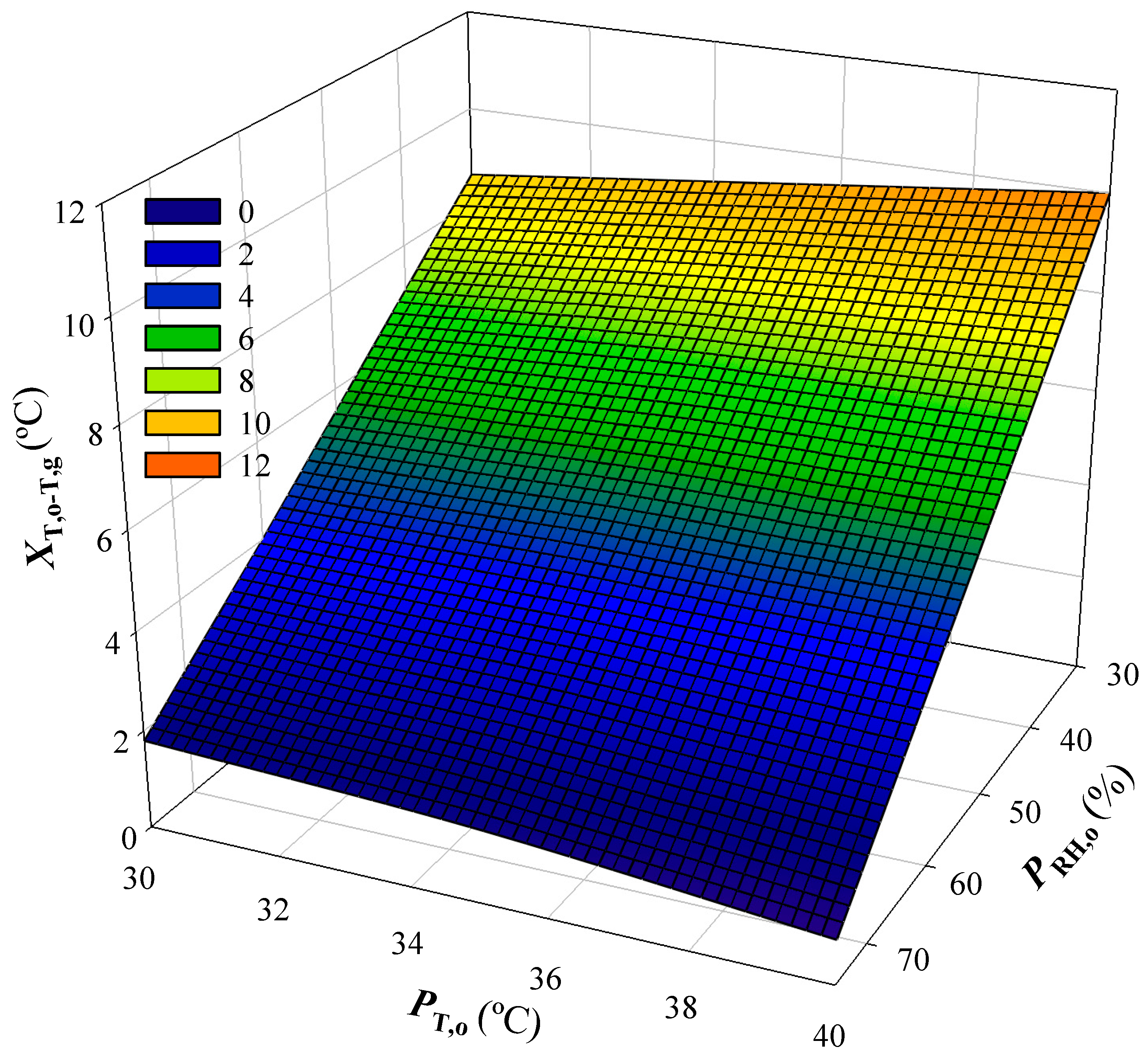

| Characteristics and Optimum Point of Functioning of the Installation | Values |
|---|---|
| Area of the fan pad (m2), | 21 |
| Thickness of the fan pad (m), | 0.10 |
| Unit and total flow rate (m3 h−1), | 6580/39,480 |
| Unit and total drive power (W), | 740/4440 |
| Performance of the fans (%), | 45.1 |
| Angular speed (rpm), | 1450 |
| Air speed in the pad (m s−1), , (= 35 °C; = 45%) | 0.54 |
| Air speed at the exit of the fan towards the duct (m s−1), | 5.90 |
| Statistical Indices | |
|---|---|
| (°C) | 0.7 |
| (°C) | 1.6 |
| (°C) | 0.8 |
| (-) | 0 |
| (-) | 1 |
| (-) | 1 |
| (30 Hz; 870 rpm) | (50 Hz; 1450 rpm) | (70 Hz; 2030 rpm) | |
|---|---|---|---|
| (W) | 160 | 741 | 2033 |
| (m3 h−1) | 3836 | 6394 | 8952 |
| (Pa) | 76 | 221 | 416 |
| (W m−2 °C−1) | 1.3 | 1.7 | 2.1 |
| (Hz) | 50 | 49 | 48 | 47 | 46 |
|---|---|---|---|---|---|
| (W) | 741 | 709 | 666 | 626 | 586 |
| (m3 h−1) | 6394 | 5674 | 5558 | 5442 | 5326 |
| (Pa) | 221 | 212 | 203 | 195 | 187 |
Disclaimer/Publisher’s Note: The statements, opinions and data contained in all publications are solely those of the individual author(s) and contributor(s) and not of MDPI and/or the editor(s). MDPI and/or the editor(s) disclaim responsibility for any injury to people or property resulting from any ideas, methods, instructions or products referred to in the content. |
© 2024 by the authors. Licensee MDPI, Basel, Switzerland. This article is an open access article distributed under the terms and conditions of the Creative Commons Attribution (CC BY) license (https://creativecommons.org/licenses/by/4.0/).
Share and Cite
Pardo-Pina, S.; Ferrández-Pastor, J.; Rodríguez, F.; Cámara-Zapata, J.M. Analysis of an Evaporative Cooling Pad Connected to an Air Distribution System of Perforated Polyethylene Tubes in a Greenhouse. Agronomy 2024, 14, 1187. https://doi.org/10.3390/agronomy14061187
Pardo-Pina S, Ferrández-Pastor J, Rodríguez F, Cámara-Zapata JM. Analysis of an Evaporative Cooling Pad Connected to an Air Distribution System of Perforated Polyethylene Tubes in a Greenhouse. Agronomy. 2024; 14(6):1187. https://doi.org/10.3390/agronomy14061187
Chicago/Turabian StylePardo-Pina, Sofía, Javier Ferrández-Pastor, Francisco Rodríguez, and José M. Cámara-Zapata. 2024. "Analysis of an Evaporative Cooling Pad Connected to an Air Distribution System of Perforated Polyethylene Tubes in a Greenhouse" Agronomy 14, no. 6: 1187. https://doi.org/10.3390/agronomy14061187








